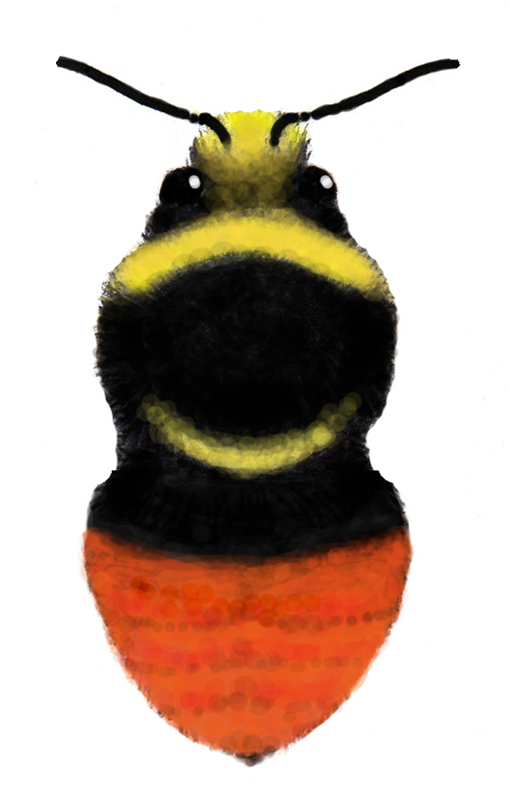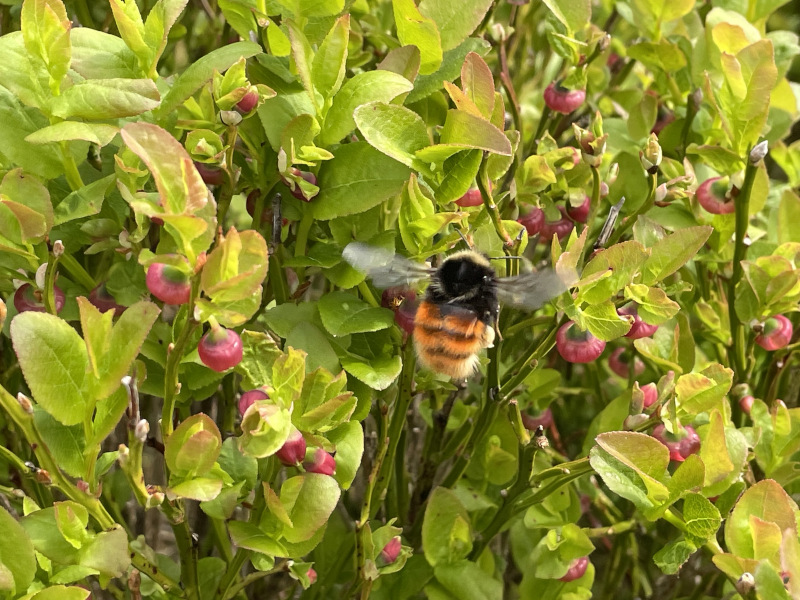 Bombus monticola is easy to identify by the extensive red-orange tail that covers more than half of its abdomen © Annie Ives
Bombus monticola is easy to identify by the extensive red-orange tail that covers more than half of its abdomen © Annie Ives

Did you know that there are around 20 different species of bumblebee in Scotland? In evolutionary terms, bumblebees are mountain creatures. They emerged from the Himalaya around 25 - 40 million years ago, well-adapted to cooler climates with home-grown belay jackets in the form of their big, furry bodies. Today, the glacial outflows and alpine meadows of the Qinghai-Tibetan Plateau are likely still home to more of the world's 250+ bumblebee species than any other region. If further proof is needed of the mountain proficiency of bumblebees, look no further than the 1921 Everest Expedition, when naturalist and expedition medic, Dr. Wollaston, collected the highest altitude record of a bumblebee to date, at an incredible 5640m (18,500 ft) above sea level!
In North-East Scotland, the beautiful, unique landscape of the Cairngorms National Park is home to some of the UK's rare, conservation-priority bumblebees, but the inaccessibility of these habitats makes monitoring them a challenge. How can we protect or conserve something, if we don't know where it is or how it's doing? This is where "mountain people" can make a real difference! Reporting bumblebee sightings in the hills is a practical way to contribute to knowledge and conservation of these precious pollinators, which are threatened by habitat loss and climate change.
Recording your bumblebee sightings, or 'biological recording', is easy to do - simply note down four key pieces of information:
A great way to log your bumblebee sightings is using iRecord, either the website or the handy app. Once you've signed up, take a photo, add a few details, and the app will automatically fill in a grid reference using built-in GPS. An alternative simple way of making your sighting count is to email our local records centre (nesbrec@aberdeenshire.gov.uk) or use the nesbrec online form.
Whichever of these methods you choose, the records end up in the same place: a large, publicly-available database which conservation organisations, researchers, planners, local authorities, students and anyone else can use to find out which bumblebees (or any other wildlife) are found where. This means that we'll be able to better protect vulnerable species and assess how distributions might be changing over time. In the UK, two species of bumblebee have already gone extinct in the past 100 years, while nearly half of the remaining bumblebee species have been designated as conservation-priority (in need of conservation action) by our devolved governments.
One very distinctive and easy-to-recognise bumblebee that hillwalkers can look out for in 2025, is Bombus monticola. Its scientific name translates as the 'mountaineer' or 'highlander' bumblebee, but in Scotland it's more commonly known as the Blaeberry bumblebee because of its association with high-altitude blaeberry-rich moorland. The mountains and moors of the Cairngorms are one of the few strongholds for this rare, conservation-priority species in the UK. As the people who frequent these areas, we are in an important position to support their conservation.
 Bombus monticola is easy to identify by the extensive red-orange tail that covers more than half of its abdomen © Annie Ives
Bombus monticola is easy to identify by the extensive red-orange tail that covers more than half of its abdomen © Annie Ives
Blaeberry bumblebees are small (typically around the size of a thumbnail) but, being so bright and beautiful, they are hard to miss or mistake! Fiery orange-red hairs cover more than half of their lower body (abdomen), while a soft yellow collar, and a band of yellow behind their wings stand out against a background of black. They are often spotted visiting willow catkins and blaeberry flowers in the spring, or heather, white clover, thistles and ragwort in summer.
You can record your sightings of Blaeberry bumblebees wherever you are, but if you're tempted to go bumblebee-bagging this year, why not head up our top pick of the peaks? These Munros and Corbetts (see list/map below) have the right habitat to support Blaeberry bumblebees, but we have no recent records for them at all.

Bumblebee-bagging peaks © Maptiler, OpenStreetMap & SRTM
Map of priority mountains to add new records of Blaeberry bumblebees.
| Top Munros | Top Corbetts |
|---|---|
| Mullach Clach a' Bhlair (NN882927) | Conachcraig (NO279865) |
| Geal-charn (NN596782) & A'Mharconaich (NN604762) | Leathad an Taobhain (NN821858) |
| Meall Chuaich (NN716878) | Brown Cow Hill (NJ221044) |
| Carn Bhac (NO051832) | Carn Mor (NJ265183) |
| Mount Keen (NO409869) | Sgor Mor (NO007914) |
For more information on how to get involved and help rare bumblebees in the hills, visit www.bumblebeeconservation.org/bumblebee-bagging or contact enquiries@bumblebeeconservation.org.
Annie is the Project Officer: Skills for Bees (Scotland) for the Bumblebee Conservation Trust.
Please let the webmaster know if there are problems with viewing these pages or with the links they contain.